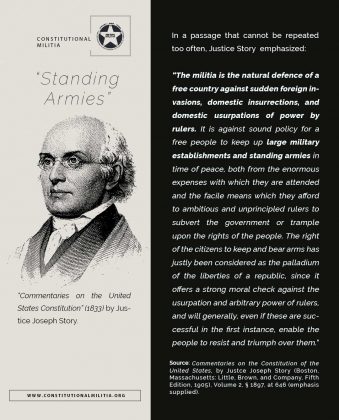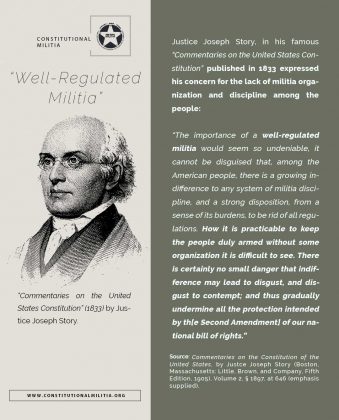Last Updated on January 15, 2023 by Constitutional Militia
Community Self-Defense Structure: Militia
The special constitutional position, status, and authority of “the Militia of the several States” their separation from the “Armies”, “Navy”, and other “Troops, or Ships of War” that the Constitution allows; and their independence of those entities must always be recognized and scrupulously applied.
2nd Amendment Reinforces the Community Self-Defense Structure as “Necessary”
The Founders of this country adopted the Second Amendment (and, for that matter, the Militia Clauses of the original Constitution in Article I, Section 8, Clauses 15 and 16, and Article II, Section 2, Clause 1). In doing so they understood—and relied upon—the principle that, “[i]n expounding the Constitution of the United States, every word must have its due force, and appropriate meaning; for it is evident from the whole instrument, that no word was unnecessarily used, or needlessly added. * * * Every word appears to have been weighed with the utmost deliberation, and its force and effect to have been fully understood’”.[1] So, with respect to the clause “[a] well regulated Militia, being necessary to the security of a free State”, “[i]t cannot be supposed that the framers of the Constitution did not use this expression with deliberation or failed to appreciate its plain significance”.[2] Obviously, the Framers both of the original Constitution and of the Second Amendment were fully aware of the relationship between individual and collective rights (and duties, for that matter) with respect to “the right of the people to keep and bear Arms”, because they conjoined those rights (and duties, too) in the Militia.
This selfsame mode of construction must apply to the 2nd Amendment. As with any other statute, the Constitution must be read as an entirety, consistently interrelating all of its provisions.[3] For all parts of the same law “must be read in relation to each other”,[4] and “reconciled so as to produce a symmetrical whole”.[5] All other things being equal, “identical words used in different parts of the same act are intended to have the same meaning”.[6] So “[w]hen the same term which has been used” in one clause of the Constitution is used in another, “it must be understood as retaining the sense originally given to it”.[7] Therefore, when the Constitution first empowers Congress “[t]o provide for organizing, arming, and disciplining, the Militia, and for governing such Part of them as may be employed in the Service of the United States”,[8] “the Militia” and “them” must refer to “the Militia” in the Constitution’s next relevant clause: namely, “the Militia of the several States”, of which Militia the President “shall be Commander in Chief * * * when [they are] called into the actual Service of the United States”.[9] And these “Militia of the several States” must be the very same “well regulated Militia * * * necessary to the security of a free State” of which the Second Amendment then speaks, if only because each and every State in the Union—that is, “the several States”, as the Constitution always describes them collectively[10]—must be taken to be “a free State” within the Amendment’s understanding of that term. So, “the Militia of the several States” that Congress is empowered “[t]o provide for organizing, arming, and disciplining” must also be understood as consisting of “the people” as a whole in each of those States.[11]
The original Constitution delegated broad legal authority to the Militia. The Second Amendment reinforced the the Militia as “necessary”, not merely “optional”. Militia are State government institutions with full constitution legal authority largely outside the jurisdiction of the General Government—what we mistakenly refer to today as the “Federal” government. As State government institutions, Militia are immune from all contemporary forms of “gun control”.
When the Framers used the word “Militia” in the Constitution they were not merely theoretical “Militia”, but instead were actual institutions—the only institutions of their kind—which existed in 1788 and had existed theretofore for generations throughout America, settled and regulated pursuant to Colonial and then State statutes.
































